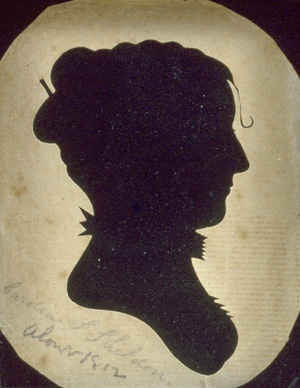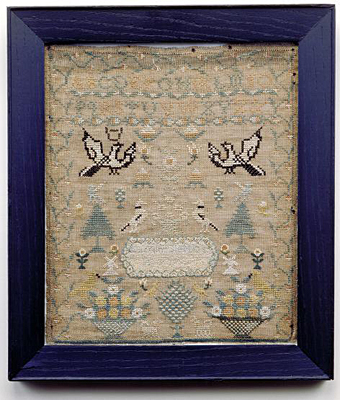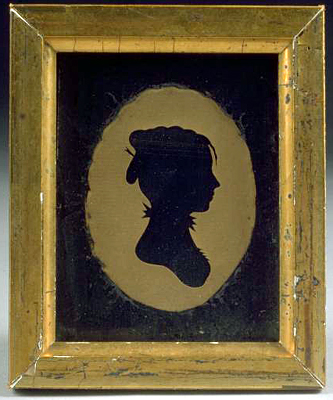In the Classroom >
Unit Overview > Lesson 12
Ornamental and
Useful Accomplishments:
Schoolgirl Education and Deerfield Academy, 1800-1830
By Suzanne L.Flynt
Deerfield, Massachusetts: Pocumtuck Valley Memorial Association and Deerfield
Academy, 1988, pp. 7-13.
"In all nations
a good education is that which renders the ladies correct in their manners,
respectable in their families, and agreeable in society. That education is
always wrong which raises a woman above the duties of her station."
Noah Webster, On the
Education of Youth in America, Boston, 1790.

Figure
1. Silhouette of Caroline Stebbins (1789-1865), c. 1804. Caroline
was the daughter of Joseph and Lucy (Frary) Stebbins of Deerfield. She attended
Deerfield Academy variously between 1804 and 1807. In 1810, she married
Seth Sheldon of Deerfield. Memorial Hall Museum. Gift of George Sheldon. |
In the late eighteenth and
early nineteenth centuries, female education was acknowledged as necessary for
improving the intellectual and moral character of young women. Within strict
boundaries set by society, their advancement was encouraged by liberal educators.
While knowledge of the basics was an important achievement in female education,
mastery of the ornamental accomplishments was essential to becoming a lady.
Deerfield has long recognized
the importance of educating its children. Primary education outside the home
was available in Deerfield as early as 1698, when the town voted to erect a
school house. Eighteenth-century town records frequently mention the hiring
of a school master, and beginning in 1728, the town occasionally employed a
school dame. In 1787 the town was divided into six school districts, and education
became available to all children in the community. The pupils, referred to as
scholars, were between the ages of four and fifteen. In 1802 the Town Street
School District voted "to keep one Man School & two Women Schools"
but stipulated that "no children under eight years old shall be sent to
the Man's School."1 The male instructor, paid approximately twice the salary
of a female counterpart, was thought to be better qualified to teach the older
children.
The primary school curriculum
varied according to the instructor, with reading and writing being the universal
goal. For young girls another discipline, which might be considered of equal
importance, was learning to stitch a sampler - a useful and necessary skill
for the life of sewing and mending which lay ahead. A large group of related
samplers worked by local girls between the ages of six and
page 7
twelve, date within a twenty-year
period, 1794 to 1814. In 1798, when Caroline Stebbins (Figure 1) was nine years
old, she completed her sampler (Figure 2). In 1809, when ten year old Mary Hawks
stitched hers, she depended upon the same set of design elements that Caroline
had used. These recurring floral, bird, and animal motifs in samplers worked
in Deerfield and in surrounding communities demonstrate that patterns were widely
shared among relatives, neighbors, and instructors, creating an identifiable
regional style. A number of samplers survive today, products of young girls
who went on to receive a secondary education, where they later completed more
difficult needlework or painting projects.
| 
Figure
2. Sampler made by "Caroline Stebbins/AE 9 1798." Caroline
confined the ubiquitous alphabet to the upper
section of her sampler and devoted the remainder of the embroidery to
birds, flowers and animals which were surely more enjoyable for a young
girl to stitch. Memorial Hall Museum. Gift of George Sheldon, 1893.
|
If eighteenth-century
Deerfield parents wanted their children to receive further education, it was
necessary to look beyond Deerfield. In the summer of 1760, the Reverend Jonathan
Ashley (1712-1780), sent his seventeen year old daughter Dolly to Boston with
the hope that she would "return with some useful improvements," but
he was greatly concerned that she would be "exposed to innumerable temptations"
and that a young woman who was not careful could become "contemptible if
after she has spent a summer in Boston; she appears haughty & disdain full,
and can talk of nothing but dress & fashions..."2 The Reverend Ashley
encouraged his daughter to "learn many excellent things, & especially
that which is virtuous" and to "shun everything that is sinfull and
that savors of pride & haughtiness: be upon your guard against every temptation;
learn to be frugal amidst an abundance, & moderate your desires whilst a
thousand things court your fancy..."3
page 9
In 1787 fifteen concerned
Deerfield residents joined to form the Proprietors of the New School House which
would offer a "higher grade of instruction." The proprietors bought
shares to underwrite the cost of building a schoolhouse, and each share allowed
the owner to send two pupils to the school, which opened in 1788. Historian
George Sheldon perceived this school to the "germ from which the Deerfield
Academy sprung ten years later." 4
Deerfield Academy, which
opened in January 1799, was established for "...the promotion of piety,
religion, and morality, and for the education of youth in the liberal arts and
sciences, and all other useful learning."5 Qualifica tions for admissions
were modest, requiring only that "Youth of both sexes, provided they are
found, in a degree, capable of reading and writing, may be admitted to the Academy."6
The education of young ladies was considered important so that not only "...the
Fathers, but, that the future Mothers of our race, may be richly furnished to
train up their children to learning and virtue, and to become the Timothies,
and Pauls, the Moseses, and Solomons, of succeeding ages."7
Education for young women
in the late eighteenth century was advocated by forward thinking educators,
but its
page 11
desirability was of dubious
concern to some young ladies. A play given at a Greenfield school in 1799 had
one of the young female characters objecting to attending school with the excuse
that "Uncle Tristam says he hates to have girls go to school, it makes
them so dam'd uppish & so deuced proud that they won't work" and "How
will the young fellows take it if we shine away & don't like their humdrum
ways - Won't they be as mad as vengeance--& associate with the girls that
don't go to school?"8 With the prospect of a future confined to household
employment, it was of questionable usefulness for many young women to want extensive
educations, since "To be obedient daughters, faithful wives, and prudent
mothers; to be useful in the affairs of a house; to be sensible companions,
and affectionate friends, are, without a doubt, the principal objects of female
daty."9 It was with these often repeated sentiments that fathers dared
to send their daughters to be educated at Deer field Academy (Figure 3).

Figure
3. Silhouette of Persis Sheldon (1785-1804), c.1804. Persis, the
daughter of John and Persis (Hoyt) Sheldon, attended Deerfield Academy in
1800. Memorial Hall Museum. Gift of George Sheldon, 1893. |
The Academy building, probably
designed by Asher Benjamin (1773-1845), was a two-story symmetrical structure
with two doorways embellished with semi-circular fan lights at the front. Preceptor
Claudius Herrick's 1799 description of the interior arrangement includes details
of room usage:
The Academy is an elegant
Edifice, having, on the lower floor, four rooms, one for the English school,
one for the Latin, Greek School, the Preceptor's room, and a room for the Museum
and Library. The upper room, being all in one, is used for examinations, and
exhibitions... We had upwards of 20 in Latin and Greek, between 20 and 30 young
Ladies studying English Grammar & Geography...10
Beginning in 1797, curiosities
from around the world, along with the important local Indian artifacts, were
collected for the Deerfield Academy Museum. The Museum, an important asset to
the Academy, partially survives to day. It is considered one of the earliest
museums in the country.11
The school year was
divided into four quarters - winter, spring, summer, and fall, with pupils attending
as little as one quarter or occasionally as many as four quarters a year. Each
quarter lasted eleven or twelve weeks. Deerfield Academy enrollment lists show
that only a few girls attended during the winter months from 1799 to 1802, while
none enrolled for winter terms from 1803 to 1810. By far the most popular quarter
for females was the summer. Academy pupils were usually in their teens, but
students as young as ten or as old as thirty were also enrolled (Figures 7).
Familial obligations, working on the farm or at-
page 12
tending a sick family member,
took priority over academic aspirations, and often the age of a pupil depended
more on family circumstances than on aptitude.

Figure
7. Portrait of Rhoda Wright Smith (1775-1818), c. 1794. Rhoda Smith
of Northfield was twenty-five years old when she attended Deerfield Academy
in the fall quarter of 1800, making her one of the older students. Rhoda's
brother-in-law, Ebenezer Hinsdale Williams of Deerfield, paid her tuition.
In 1807, she married Henry Bardwell and settled in Deerfield. Memorial Hall
Museum. Gift of Mrs. C.E.B. Allen, 1889. |
The tuition for Deerfield
Academy was set in 1798 by the Trustees: "$2.00 a quarter for each scholar
instructed in reading, writing and English grammar. $2.50 for each scholar instructed
in any other branch of literature. Plus an equal proportion of the Fuel. 17
cents for each quarter for the purpose of defraying contingent charges."12
On the last Tuesday in each
quarter, public examinations of the pupils were held "in the various branches
of academic learning," and, twice a year, the students would demonstrate
their newly acquired knowledge during a program of "speeches, declamations,
dialogues, and orations"13 attended by parents, trustees, and townspeople.
These exhibitions also provided an opportunity to display accomplishments in
ornamental branches. Afterwards, pupils and their guests celebrated with an
Exhibition Ball.
page 13



